
Tutankhamun or Tutankhamen,, was an ancient Egyptian pharaoh who ruled c. 1332 – 1323 BC during the late Eighteenth Dynasty of ancient Egypt. Born Tutankhaten, he was likely a son of Akhenaten, thought to be the KV55 mummy. His mother was identified through DNA testing as The Younger Lady buried in KV35; she was a full sister of her husband.

Aten, also Aton, Atonu, or Itn was the focus of Atenism, the religious system formally established in ancient Egypt by the late Eighteenth Dynasty pharaoh Akhenaten. Exact dating for the Eighteenth Dynasty is contested, though a general date range places the dynasty in the years 1550 to 1292 BCE. The worship of Aten and the coinciding rule of Akhenaten are major identifying characteristics of a period within the Eighteenth Dynasty referred to as the Amarna Period.

Akhenaten, also spelled Akhenaton or Echnaton, was an ancient Egyptian pharaoh reigning c. 1353–1336 or 1351–1334 BC, the tenth ruler of the Eighteenth Dynasty. Before the fifth year of his reign, he was known as Amenhotep IV.

Nefertiti was a queen of the 18th Dynasty of Ancient Egypt, the great royal wife of Pharaoh Akhenaten. Nefertiti and her husband were known for their radical overhaul of state religious policy, in which they promoted the earliest known form of monotheism, Atenism, centered on the sun disc and its direct connection to the royal household. With her husband, she reigned at what was arguably the wealthiest period of ancient Egyptian history. After her husband's death, some scholars believe that Nefertiti ruled briefly as the female pharaoh known by the throne name, Neferneferuaten and before the ascension of Tutankhamun, although this identification is a matter of ongoing debate. If Nefertiti did rule as pharaoh, her reign was marked by the fall of Amarna and relocation of the capital back to the traditional city of Thebes.
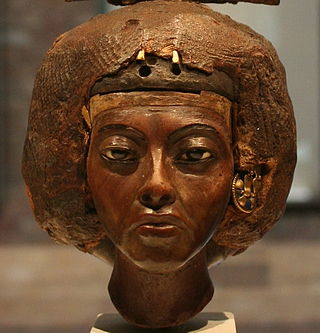
Tiye was the Great Royal Wife of the Egyptian pharaoh Amenhotep III, mother of pharaoh Akhenaten and grandmother of pharaoh Tutankhamun; her parents were Yuya and Thuya. In 2010, DNA analysis confirmed her as the mummy known as "The Elder Lady" found in the tomb of Amenhotep II (KV35) in 1898.
Monolatry is the belief in the existence of many gods, but with the consistent worship of only one deity. The term monolatry was perhaps first used by Julius Wellhausen.

Kiya was one of the wives of the Egyptian Pharaoh Akhenaten. Little is known about her, and her actions and roles are poorly documented in the historical record, in contrast to those of Akhenaten's 'Great royal wife', Nefertiti. Her unusual name suggests that she may originally have been a Mitanni princess. Surviving evidence demonstrates that Kiya was an important figure at Akhenaten's court during the middle years of his reign, when she had a daughter with him. She disappears from history a few years before her royal husband's death. In previous years, she was thought to be mother of Tutankhamun, but recent DNA evidence suggests this is unlikely.

Horemheb, also spelled Horemhab, Haremheb or Haremhab, was the last pharaoh of the 18th Dynasty of Egypt. He ruled for at least 14 years between 1319 BC and 1292 BC. He had no relation to the preceding royal family other than by marriage to Mutnedjmet, who is thought to have been the daughter of his predecessor, Ay; he is believed to have been of common birth.
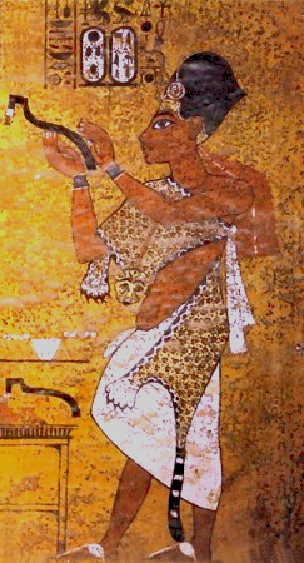
Ay was the penultimate pharaoh of ancient Egypt's 18th Dynasty. He held the throne of Egypt for a brief four-year period in the late 14th century BC. Prior to his rule, he was a close advisor to two, and perhaps three, other pharaohs of the dynasty. It is speculated that he was the power behind the throne during child ruler Tutankhamun's reign, although there is no evidence for this aside from Tutankhamun's youthfulness. His prenomenKheperkheperure means "Everlasting are the Manifestations of Ra", while his nomenAy it-netjer reads as "Ay, Father of the God". Records and monuments that can be clearly attributed to Ay are rare, both because his reign was short and because his successor, Horemheb, instigated a campaign of damnatio memoriae against him and the other pharaohs associated with the unpopular Amarna Period.
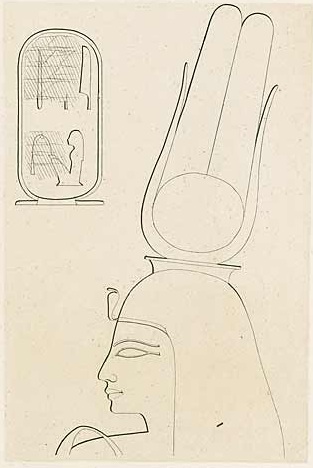
Tey was the Great Royal Wife of Kheperkheprure Ay, who was the penultimate pharaoh of Ancient Egypt's Eighteenth Dynasty. She also had been the wet nurse of Nefertiti.

The New Kingdom, also called the Egyptian Empire, refers to ancient Egypt between the 16th century BC and the 11th century BC. This period of ancient Egyptian history covers the Eighteenth, Nineteenth, and Twentieth dynasties. Through radiocarbon dating, the establishment of the New Kingdom has been placed between 1570 BC and 1544 BC. The New Kingdom followed the Second Intermediate Period and was succeeded by the Third Intermediate Period. It was the most prosperous time for the Egyptian people and marked the peak of Egypt's power.

Atenism, also known as the Aten religion, the Amarna religion, the Amarna revolution, and the Amarna heresy, was a religion in ancient Egypt. It was founded by Akhenaten, a pharaoh who ruled the New Kingdom under the Eighteenth Dynasty. The religion is described as monotheistic or monolatristic, although some Egyptologists argue that it was actually henotheistic. Atenism was centered on the cult of Aten, a god depicted as the disc of the Sun. Aten was originally an aspect of Ra, Egypt's traditional solar deity, though he was later asserted by Akhenaten as being the superior of all deities.
The Amarna Period was an era of Egyptian history during the later half of the Eighteenth Dynasty when the royal residence of the pharaoh and his queen shifted from the old capital of Thebes (Waset) to Akhetaten in what is now modern Amarna. This move occurred during the reign of Amenhotep IV, who changed his name to Akhenaten in order to reflect the dramatic change of Egypt's polytheistic religion into one where the sun disc Aten was worshipped over all other gods. Toward the end of a Akhenaten's reign, he had a mysterious co-regent, Smenkhkare, about which very little is known; similarly, Neferneferuaten, a female ruler also exercised influence.
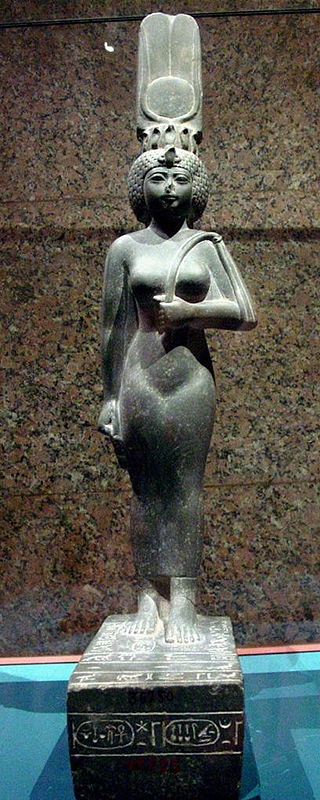
God's Wife of Amun was the highest-ranking priestess of the Amun cult, an important religious institution in ancient Egypt. The cult was centered in Thebes in Upper Egypt during the Twenty-fifth and Twenty-sixth dynasties. The office had political importance as well as religious, since the two were closely related in ancient Egypt.

Meketaten was the second of six daughters born to the Egyptian Pharaoh Akhenaten and his Great Royal Wife Nefertiti. She likely lived between Year 4 and Year 14 of Akhenaten's reign. Although little is known about her, she is frequently depicted with her sisters accompanying her royal parents in the first two-thirds of the Amarna Period.

Akhnaton is a play by Agatha Christie. It was written in 1937, around the same time she was writing Death on the Nile. It is set in Ancient Egypt, and followed the exploits of the Egyptian Pharaoh Akhnaton, his wife Nefertiti and his successor Tutankhaton. In writing the play, Christie was assisted by the eminent Egyptologist, Stephen Glanville, who was a friend of both her and her husband, Max Mallowan.

Neferneferuaten Tasherit or Neferneferuaten the younger was an ancient Egyptian princess of the 18th Dynasty and the fourth daughter of Pharaoh Akhenaten and his Great Royal Wife Nefertiti.
Amun was a major ancient Egyptian deity who appears as a member of the Hermopolitan Ogdoad. Amun was attested from the Old Kingdom together with his wife Amunet. His oracle in Siwa Oasis, located in Western Egypt near the Libyan Desert, remained the only oracle of Amun throughout. With the 11th Dynasty, Amun rose to the position of patron deity of Thebes by replacing Montu.
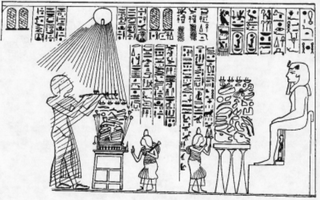
Bek or Bak was the first chief royal sculptor during the reign of Pharaoh Akhenaten. His father Men held the same position under Akhenaten's father Amenhotep III; his mother Roi was a woman from Heliopolis.

The Eighteenth Dynasty of Egypt is classified as the first dynasty of the New Kingdom of Egypt, the era in which ancient Egypt achieved the peak of its power. The Eighteenth Dynasty spanned the period from 1550/1549 to 1292 BC. This dynasty is also known as the Thutmoside Dynasty) for the four pharaohs named Thutmose.

















